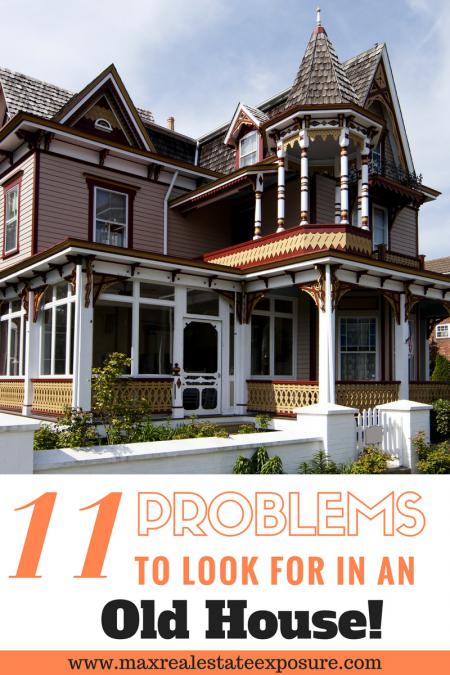Common Issues With Older Homes
 Are you considering buying an old house?
Are you considering buying an old house?
Buying an old home may allow you to live in a stylish, affordable piece of history. Unfortunately, it can also bring many issues you may not be prepared for.
What seems like a great deal initially may cost way more than you bargained for. There are problems to look for when buying an old house you should be mindful of.
It always pays to research before investing in real estate, particularly when the property was built over 50 years ago.
The following tips will give you an idea of what issues to watch out for when buying an older home.
Avoid getting caught up in the house’s potential before you look carefully at these problem areas.
If you purchase an antique, you should be even leerier about doing your due diligence.
When buying an old house, knowing how to pick a home inspector that will go through the house with a fine toothcomb pays dividends.
While inspecting any home is essential, checking for problems in older homes becomes even more paramount.
Look at the tips for buying an antique, including highlights of things you may want to research further. Not only should you be studying the structure but the house’s history as well.
You never know what you will uncover!
Problems With Old Houses to Look For
Old dream houses can captivate the imagination. You can do so many things with older homes to add your personality. However, before pulling the trigger, it is essential to understand the potential issues.
1. Asbestos
Asbestos makes an incredibly useful flame retardant, which is part of why it is so commonly used in older buildings. Unfortunately, when airborne, the barbed fibers can be inhaled and lodged in the lining of the lungs, eventually leading to a deadly form of cancer.
The EPA finally banned using asbestos in building materials in 1989.
Many older homes have had the asbestos removed and replaced with something safer, but some have not. You want to know if the home you are interested in still has asbestos. If it does, you must consider the removal costs, which can be pricey.
While a good home inspector can point out what looks to be asbestos, you cannot tell for sure unless it is tested. Much of the asbestos found in homes was on wrapping found on pipes in the basement and used as insulation.
There is, however, another area where asbestos can be quite common in older homes, and that is the flooring. What you may think looks like dull linoleum could, in fact, harbor asbestos. It is typically only a problem if these tiles are cracked, flaking, or otherwise damaged.
If they remain intact, there shouldn’t be an issue with them.
2. Lead paint
While lead paint is #2 on my list, it is the #1 problem you should address when buying an older home. The lead must be removed if you have a child under six living in the house. It is a federal law!
As a buyer of older homes, you should understand the lead paint law.
When people consume lead, it can cause significant health problems, particularly in growing children. Homes built before 1978 could have lead paint, so property owners must disclose the possible existence of lead paint to renters or buyers.
You can paint over the old paint, but the dangerous lead paint will remain underneath.
Massachusetts has an excellent form explaining how the lead paint law works. You should take lead paint very seriously when buying an old house. Do your research and due diligence regarding the lead paint law.
Not too long ago, I was involved in selling a two-family home in Hopedale, Massachusetts, where a tenant was living in one of the units with a child under the age of six.
After the buyer inspected the home, they discovered it had lead paint. A house confirmed to have lead paint can present a series of issues that you need to be keenly aware of, including your responsibilities as an owner.
When buying an older property, a home inspection checklist is essential to check for these types of potential issues.
3. Problems Found With The Foundation & Sills.
 The foundation of older homes can be cracked, leaning, sunken, or otherwise damaged and in need of repair. Everything else in the house sits on the foundation, so foundation issues must be addressed for safety and to keep the home livable.
The foundation of older homes can be cracked, leaning, sunken, or otherwise damaged and in need of repair. Everything else in the house sits on the foundation, so foundation issues must be addressed for safety and to keep the home livable.
Of course, all foundation problems are not equal. A few settlement cracks may be expected and safe, but you need an inspector to tell you one way or the other.
Foundation repair can be expensive, something to remember when considering the home’s price.
One issue that is even more prevalent in older homes is damage to the sill plate. Over an extended period, the sills in a home can become susceptible to water, insects, and other external elements.
The entire building rests on the sill plate, which sits on the foundation. With older homes having sill plate problems is not uncommon at all.
Checking the sills carefully is something that a qualified inspector should do. The sills can be fixed if damaged, but often, it requires jacking up the home, which can cause damage to walls, such as cracking, if not done carefully.
Sill problems are not uncommon when buying an antique. Here is a terrific resource on what you need to know about sill damage.
4. Electrical Problems
The electrical systems in old homes were not designed to keep up with modern usage. Computers, mobile devices, televisions, HVAC systems, appliances, dishwashers, washers/dryers – we use a lot of electricity, far more than people did fifty or more years ago.
If your lifestyle includes using a variety of electronics, you want to ensure that the home you are buying will work for your needs.
One of the more common problems to look for in an older home is knob and tube wiring. Knob and tube wiring were prevalent from the 1890s to the 1930s. It became far less used right around 1950.
This type of wiring consisted of single-insulated copper conductors run within the walls or ceilings, passing through joist and stud drill-holes via protective porcelain insulating tubes.
They were supported on nailed-down porcelain knob insulators. Where conductors entered a wiring device such as a lamp or switch or were pulled into a wall, they were protected by flexible cloth insulating sleeves called a loom. The first insulation was asphalt-saturated cotton cloth. Then rubber became common.
As a home buyer, you must understand that knob and tube systems cannot handle the power usage level in today’s modern homes.
One of the big problems with knob & tube wiring is that homeowners often abuse the system by replacing blown fuses with fuses rated for higher currents. By doing so, the wiring was subject to higher levels of current that risked heat damage or fire.
Another problem with knob and tube wiring was the prevalence to be damage caused by home renovations. Its cloth and rubber insulation dried out and quickly turned brittle. It could also be damaged by rodents chewing on the wiring.
You May Not Be Able to Get Insurance With Knob and Tube Wiring
The biggest problem, however, with knob and tube wiring is the ability to get homeowners insurance. Many insurance companies will not write insurance on homes with knobs and tubes.
Many companies will insist the knob and tube wiring is replaced or that an electrician certifies that the wiring is in good condition.
Additionally, many lenders will not give a mortgage to a borrower purchasing a home with knob and tube wiring. If you buy an antique with knob and tube wiring, it makes sense to speak with your mortgage lender and insurance company upfront.
5. Ungrounded outlets
 Look around the home at the electrical outlets. Do they have three holes or only two? If they only have two, you cannot use devices that require grounding in the outlet – like your computer or your new flat-screen television.
Look around the home at the electrical outlets. Do they have three holes or only two? If they only have two, you cannot use devices that require grounding in the outlet – like your computer or your new flat-screen television.
While cheap adapters are unsafe for long-term use, you will need an electrician to fix the problem eventually.
Here is an excellent resource on how to go about fixing ungrounded outlets. Dealing with ungrounded outlets is not the end of the world and certainly not a reason to avoid purchasing a home.
6. Insurance costs
If your house has old electrical or plumbing systems, getting homeowners insurance may be difficult or expensive.
Many policies won’t cover damage caused by old, worn-out systems. To get insurance, you may have to update your home extensively, which will cost a lot of money.
Be sure to check out this guide to homeowners insurance, where you can get a good handle on everything you need to know about protecting your valuable asset.
7. Roofing issues
Like everything else on the home, the roof may have seen better days. You may look up and see missing shingles, moss, or patches of new shingles placed over the old. Or, you may see what looks like a roof in good repair, but the inspector may discover issues that are not visible to you from the ground.
There are definite signs that you need a new roof. Look and see how to tell if you need a new roof.
Remember that previous owners may have chosen to save money by adding new shingles over the old across the entire roof, which will look uniform but is not the right way to replace the roof.
Done more than once, it can cause damage to the home.
8. Issues With Water Are Prevalent With Older Houses
If you buy an older home, the odds are increased that you could purchase property with an old-style water source. Many years ago, people had hand-dug wells as their sole water source.
Having a hand dug well can cause some pretty significant issues. Today’s modern homes are equipped with artesian wells that are drilled.
The problem with shallow-dug wells is an increased risk of contaminants. Look at this comprehensive guide to buying a home with well water. Your drinking source is something you don’t want to take chances with. Many home buyers skip the well water test, which can be a critical mistake.
9. Older Homes Lack Energy Efficiency
 Older homes were not built with energy efficiency in mind. Many do not have any insulation, or the insulation that they do have is old and ineffective.
Older homes were not built with energy efficiency in mind. Many do not have any insulation, or the insulation that they do have is old and ineffective.
The windows are often single-pane. To get the most out of any heating or air conditioning, you must update the insulation and the windows in an older home.
If you purchase an antique, I highly recommend becoming familiar with the best energy upgrades for an old house.
One of the first things you should do is get a home energy audit. These evaluations are relatively inexpensive and often free.
A professional doing an energy audit on an older home can save you a lot of money!
10. Insects and Pests
An old home usually has unwanted guests that stick around long after the owner has moved on. Insects, rats, mice – older homes are ideal for pests you probably don’t want to live with.
Some of them can be inconvenient, while others can be health hazards.
If termites are an issue, you may find that some regions of the home are in worse repair than you initially realized. An inspector can tell you more about the home you are looking at but don’t be surprised if they find several pest problems.
Insects are more common in older homes with older wood that may have water damage. It would be best to take extreme care of termites when purchasing an older home or any property.
Don’t be surprised if the inspector points out old powder post-beetle damage when purchasing an antique. Usually, these bugs are not still active. However, you must ensure the existing damage will not adversely affect the structure.
11. Paranormal Activity is More Common in Older Homes
Does the thought of having ghosts in your home bother you? You should know that older houses often come with unwanted guests.
Real Estate agents refer to these homes as stigmatized properties. A stigmatized property could include paranormal activity, hauntings, murder, suicide, or other home value issues.
If having spirits in your home bothers you, doing more in-depth research on the home’s death history will be essential.
You might ask the current owner if they suspect the home is haunted. In most states, disclosing paranormal activity is not required. However, sellers cannot lie when asked a direct question. It could open them up to a lawsuit.
Remember that many people die in their homes today from natural causes. It doesn’t necessarily mean there is a problem.
12. Outdated Floor Plans
While old dream houses can be magnificent, some can have unfunctional, dated floor plans. Some of them will have many small rooms that don’t seem to have a function for today’s living.
Even worse is when there is functional obsolescence, like having to go through one bedroom to get to another.
If this sounds like the house you’re considering purchasing, you may want to see if walls can be removed to open up the floor plan to something more functional.
13. A Realtor Unfamiliar With Older Homes
Any experienced Realtor has probably sold quite a few older homes and will be aware of all the possible problems buyers can run into. But not all Realtors are experienced, and you may work with someone with little experience in this area.
If you are considering older homes, ask your Realtor if they have experience with them. You are making a big purchase you want to be happy with. Work with an agent you can depend on to guide you effectively and look out for your interests.
One of the more significant stumbling blocks in buying an older home will be the home inspection and subsequent negotiations for any needed repairs. You will need someone in your corner who is a skilled negotiator. If your agent doesn’t understand the issues, it is tough to do that.
At the bare minimum, your real estate agent should attend the home inspection to hear the problems. Many agents skip the home inspection, which is a huge mistake.
Final Thoughts on Buying an Older House
Buying a piece of history can be an exciting proposition. However, knowing precisely what you’re buying when it’s an antique is paramount.
Older homes tend to have more significant problems than younger properties. As long as you do your due diligence, I am sure you’ll have a property to be excited about for many years.
Buying an old house checklist like the information found here could be valuable.
About the Author: The above Real Estate information on the problems to look for when buying an old house was provided by Bill Gassett, a Nationally recognized leader in his field. Bill can be reached via email at billgassett@remaxexec.com or by phone at 508-625-0191. Bill has helped people move in and out of Metrowest towns for the last 37+ Years.
Are you thinking of selling your home? I am passionate about Real Estate and love sharing my marketing expertise!
I service Real Estate sales in the following Metrowest MA towns: Ashland, Bellingham, Douglas, Framingham, Franklin, Grafton, Holliston, Hopkinton, Hopedale, Medway, Mendon, Milford, Millbury, Millville, Northborough, Northbridge, Shrewsbury, Southborough, Sutton, Wayland, Westborough, Whitinsville, Worcester, Upton, and Uxbridge MA.

